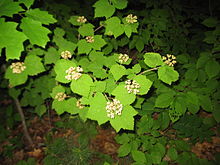- Viburnum acerifolium
-
Viburnum acerifolium 
Conservation status Scientific classification Kingdom: Plantae (unranked): Angiosperms (unranked): Eudicots (unranked): Asterids Order: Dipsacales Family: Adoxaceae Genus: Viburnum Species: V. acerifolium Binomial name Viburnum acerifolium
L.Viburnum acerifolium (Maple-leaf Viburnum or Dockmackie) is a species of Viburnum, native to eastern North America from southwestern Quebec and Ontario south to northern Florida and eastern Texas.
It is a shrub growing to 1-2 m tall. The leaves are in opposite pairs, 5-10 cm long and broad, three- to five-lobed, the lobes with a serrated margin. The flowers are white with five small petals, produced in terminal cymes 4-8 cm diameter. The fruit is a small red to purple drupe 4-8 mm long.
The scientific and common names refer to the superficial similarity of the leaves to those of some maples (Acer); the plant is occasionally mistaken for young maples, but is readily distinguished by the flowers and fruit; the viburnum produces small, purple berries, while maples produce dry, winged seeds.
References
- ^ "Viburnum acerifolium". NatureServe Explorer. NatureServe. http://www.natureserve.org/explorer/servlet/NatureServe?searchName=Viburnum+acerifolium+. Retrieved 2007-07-06.
Categories:- NatureServe Secure species
- Viburnum
- Flora of Ontario
- Flora of Quebec
- Flora of Connecticut
- Flora of Indiana
- Flora of Maine
- Flora of Massachusetts
- Flora of Michigan
- Flora of New Hampshire
- Flora of New Jersey
- Flora of New York
- Flora of Ohio
- Flora of Pennsylvania
- Flora of Rhode Island
- Flora of Vermont
- Flora of West Virginia
- Flora of Illinois
- Flora of Alabama
- Flora of Delaware
- Flora of Florida
- Flora of Georgia (U.S. state)
- Flora of Kentucky
- Flora of Louisiana
- Flora of Maryland
- Flora of Mississippi
- Flora of North Carolina
- Flora of South Carolina
- Flora of Tennessee
- Flora of Texas
Wikimedia Foundation. 2010.

